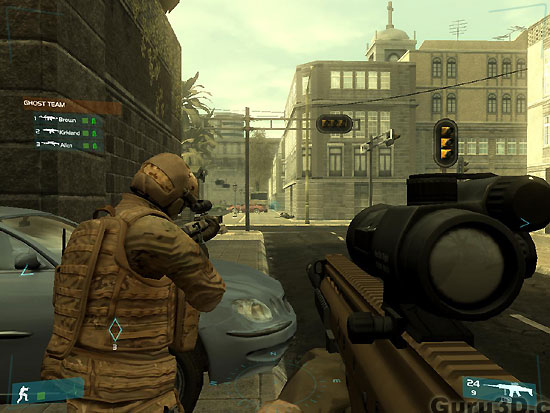Page 24
Splinter Cell 3 - Chaos Theory
Sam Fisher returns for his third installment. Splinter Cell: Chaos Theory, the third game in the acclaimed Splinter Cell series, manages to improve the games visuals, make the gameplay a bit more nonlinear and adds some new gameplay modes to the already exhaustive Splinter Cell brand. Anyone who has seen Chaos Theory in action can attest to its visual masterpiece. Dynamic lighting is back in a big way. No longer are shadows blobby, elongated representations of the characters. Now we have shadows that are detailed and exact.
Another of the biggest renovations of the graphics is the amazing use of bump and normal mapping. Now when you are sulking around in the shadows of espionage Sam actually has a recognizable face, with expressions and features that look real. Rather than the flat textured faces we have seen in the games previous.
The game is so darn good.
Splinter Cell 3 has been out for a while now and we recently recorded a timedemo. Finally we have a title that can utilize and stress a high-end graphics card. Let me tell you what we enabled in our configuration.
First off, we disabled Antialiasing to make future proof benchmarks. Why? Because there is a difference in the benchmark modes between ATI and NVIDIA. The x number in "AntiAliasing=x" DOES NOT correspond with the number of anti-aliasing samples. Next to that Shader Model 3.0 and enable HDR rendering, anti-aliasing will result in AA always be disabled.
- Shadow Quality is set to high resolution.
- Anisotropic filtering is set to 16x
- Trilinear filtering is used
- Specular lighting is enabled
- Soft shadows are enabled
- Parallax mapping is enabled
- High Dynamic Range rendering is enabled
- Hardware Shadow mapping is enabled
This really is a tough nut to crack for most cards. We measured performance with 16 levels of AF enabled and had HDR is activated. Only in the lower resolutions we see a clear performance differential.
Tom Clancy's Ghost Recon: Advanced Warfighter
In Tom Clancy's Ghost Recon 3, players will embody Captain Scott Mitchell as he commands the Ghosts and Special Forces allies equipped with the IWS in the quest to save the president of the United States, recover stolen nuclear codes and eliminate a vicious band of renegade soldiers hell-bent on unleashing catastrophe. The game unfolds entirely in Mexico City, where numerous, thoroughly researched and detailed environments will deliver complete immersion into the future of urban warfare.
Don't mistake the PC version for being a port of the Xbox 360 game. The PC version has larger and different levels than those featured on the Xbox 360, as well as a different graphics engine and style of gameplay. The game itself looks great, and the intricate physics modeling seen in the single-player version is still active in the multiplayer version. In fact, it's so detailed that if you have the upcoming Aegia physics card, you'll see sparks bouncing off objects in the environment. Even if you don't have a physics card, though, there are all sorts of other interactions you'll encounter in multiplayer. For instance, aluminum cans litter the street, and stepping on them not only kicks them around, but also creates a loud sound, which may betray your presence to the enemy.
You need to have a graphics monster as graphics card as this baby can be hard on current graphics cards, even high-end ones. So we are playing the level Coup d' Etat (Checkpoint 2) here (fantastic level). Configuration wise we enable as always all eye-candy. This game does not support AA by the way. We have 16xAF enabled, and furthermore all settings set to high. So again, we have every possible bell & whistle enabled but it is quite shocking to see a game taking such a hefty toll on this not exactly cheap gaming rig.
66 FPS at 1920x1200 people :)

